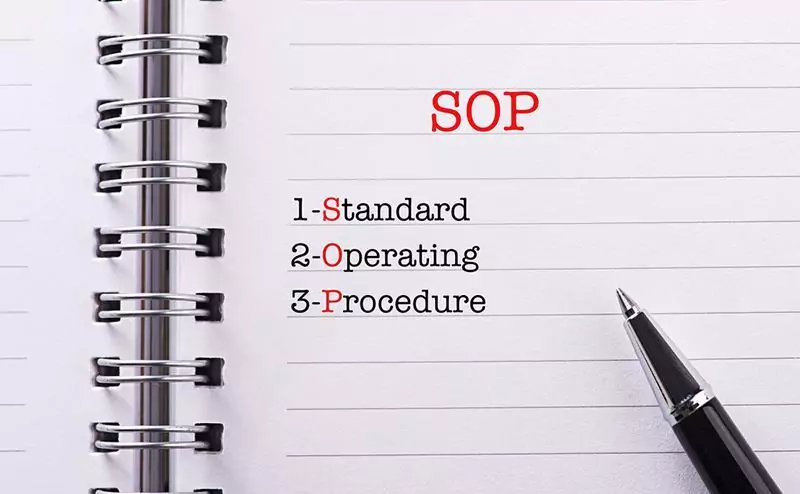For everyone working in the Pharmaceutical Industry, Standard Operating Procedures (SOPs) are a routine part of day to day operations. An SOP as defined by Wikipedia is a set of step-by-step instructions compiled by an organization to help workers carry out complex routine operations. SOPs aim to achieve efficiency, quality output and uniformity of performance, while reducing miscommunication and failure to comply with industry regulations.
SOPs need to provide clear instruction to the end user on how to perform a task, and sufficient detail to allow the task to be executed in a consistent and uniform manner by all end users. Many processes can be complex in nature and it is important to get the balance right between too little and too much detail. If there is too little detail this increases the potential for the end user to follow their own way of doing things. On the other hand, too much information and excessive detail increases the risks that the end user has difficulty understanding and following the steps on a daily basis, leading to errors and mistakes.
When writing or updating SOPS, remember these important points to avoid complexity:
Author & Reviewer: Ensure that the author of the procedure is the person that performs the task and/or understands it well while at the same time avoids going into excessive detail. The reviewer should ensure that the balance between too little and too much detail is assessed.
Ask Why: This technique helps to simplify and improve your work flow for a new process or for revising your procedures. This can start with making a list of every single step in a work process from start to end. At each step of the SOPs carefully ask “why is this step required?”.
Red Line the procedure in the field: This is a great way to test if the procedure is still relevant and whether it makes sense. Use this time to take clear photos that you can add into your documents. There can be huge benefit in redlining or writing a procedure in the field and getting the process documented and recorded correctly.
Maintain Simplicity: Long, complex SOPs can be difficult to follow. Strive to keep your SOPs simple and easy to use while still ensuring all important steps are included. Break down complex tasks into smaller sub-steps. In general, keep your sentences as short as possible.
Photos/ Drawings/ Flow Charts: The majority of the human brain is dedicated to processing visual information. Make your procedures easy to understand by including photos, drawings and flow charts. Humans prefer visuals to text, so it makes sense to use more visual information to explain complicated information. Include illustrations, diagrams, flowcharts or other visual aids that can help with understanding.
Reduce the number of people involved in the tasks: The more people you have involved in a task, the more chance there is for mistakes. By reducing the number of people involved in a task, you can greatly improve how quickly it can be done and ensure that it’s done correctly.
Consider your audience: SOPs should be based on the education, experience, knowledge and abilities of the personnel who will use the SOP.
Test and verify SOP function: Once the SOP is drafted, test it with those individuals who will be use it routinely. Have them follow the SOP from beginning to end to ensure the information is clear, that all the required steps are included and are in the correct sequence. Also consider having someone with limited knowledge of the process test the SOP.
Protect what you have simplified: During the review process don’t let people put in additional steps or put back in what you’ve taken out without adequate justification. Exercise caution when updating SOPs as the corrective action or preventative action (CAPA) for deviations unless it is clearly identified through your root cause analysis.
Review and revise, as needed: Once the SOP has been in use for several weeks, ask for responses from those with direct experience using it. Ensure that the SOP is clear, accomplishes its purpose and is easy to read and use. Revise based on the feedback you receive.
Keep your SOPs up to date: Maintaining your SOPS in line with current practice and requirements is key. Without periodic review of SOPs and regular updates, they can quickly become out-of-date. To keep this from happening. SOPs should be reviewed at least every two to three years. Some SOPs may need to be reviewed on a more frequent basis, especially if the process they explain is updated or changes
A list of SOP’s required by the FDA, EU GMP and WHO for GMP activities – http://www.gmp-compliance.org/gmp-news/which-sops-are-required-by-gmp
For GDP, the HPRA have published a guidance document that includes the SOPs that are needed for compliance with GDP and details the general framework for each SOP https://www.hpra.ie/docs/default-source/publications-forms/guidance-documents/ia-g0038-guide-to-quality-system-for-general-sale-wholesale-distributors-v2.pdf?sfvrsn=14.
If you are interested in exploring how we can help you, please get in touch to discuss how PharmaLex Irleand can assist your organisation, contact us at +353 1 846 47 42 or contactirl@pharmalex.com.








